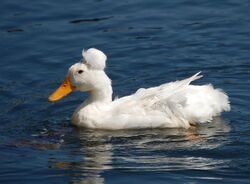Biology:Crested (duck breed)
The Crested is a breed of domestic duck. It was probably brought to Europe from the East Indies by Dutch ships.[3]:413 It has its appearance because it is heterozygous for a genetic mutation causing a deformity of the skull.
History
The Crested probably originates in the East Indies, with subsequent development in Holland.[3]:413 Crested ducks are seen in seventeenth-century paintings such as those of Melchior d'Hondecoeter and Jan Steen.[7]:441
In the United States the breed was described by D.J. Browne in 1853.[3]:413[8]:197 The white Crested was added to the American Standard of Perfection in 1874; the black variant was added in 1977.[4] The Crested was recognised in the United Kingdom in 1910.[3]:413
A bantam version of the breed, the Crested Miniature, was bred by John Hall and Roy Sutcliffe in the United Kingdom in the late twentieth century; it was recognised in 1997.[3]:415
Characteristics
Apart from the crest, the Crested is an ordinary-looking duck of medium size. It may be of any colour, although in the United States only black and white are recognised; in the UK, as in several other European countries, any colour is permitted.[7]:441[5] The crest varies widely in size, from unnoticeably small to a diameter of approximately 13 cm.[9] They have long, slightly arched necks, medium length body, much depth and fullness through the breast.[10]
Though Cresteds can be good layers and have strong roasting qualities, the main interest and demand for the breed is as pets and decorations. They are not a popular show breed due to challenges associated with the crest genes also causing a fat body within the skull. Depending on the fat body's size and relative position to the brain, it can impede a duck's ability to ambulate. Many crested ducks experience a "tottering" walking pattern and, if knocked over, are unable to get up. Other issues caused by the fat body may include seizures, neurological problems, and even early death. [11]
References
- ↑ Barbara Rischkowsky, Dafydd Pilling (editors) (2007). List of breeds documented in the Global Databank for Animal Genetic Resources, annex to The State of the World's Animal Genetic Resources for Food and Agriculture. Rome: Commission on Genetic Resources for Food and Agriculture, Food and Agriculture Organization of the United Nations. ISBN 9789251057629. Archived 23 June 2020.
- ↑ Transboundary breed: Crested. Domestic Animal Diversity Information System of the Food and Agriculture Organization of the United Nations. Accessed August 2022.
- ↑ Jump up to: 3.0 3.1 3.2 3.3 3.4 3.5 3.6 Victoria Roberts (2008). British poultry standards: complete specifications and judging points of all standardized breeds and varieties of poultry as compiled by the specialist breed clubs and recognised by the Poultry Club of Great Britain. Oxford: Blackwell. ISBN:9781405156424.
- ↑ Jump up to: 4.0 4.1 APA Recognized Breeds and Varieties: As of January 1, 2012. American Poultry Association. Archived 4 November 2017.
- ↑ Jump up to: 5.0 5.1 Liste des races et variétés homologuée dans les pays EE (28.04.2013). Entente Européenne d’Aviculture et de Cuniculture. Archived 16 June 2013.
- ↑ Breed Classification. Poultry Club of Great Britain. Archived 12 June 2018.
- ↑ Jump up to: 7.0 7.1 J. Ian H. Allonby, Philippe B. Wilson (editors) (2018). British Poultry Standards: complete specifications and judging points of all standardized breeds and varieties of poultry as compiled by the specialist breed clubs and recognised by the Poultry Club of Great Britain, seventh edition. Chichester; Hoboken, New Jersey: Wiley Blackwell. ISBN 9781119509141.
- ↑ D.J. Browne, Samuel Allen (1853 [1849]). The American poultry yard : comprising the origin, history, and description of the different breeds of domestic poultry, with complete directions for their breeding, crossing, rearing, fattening, and preparation for market …. New York: C.M. Saxton.
- ↑ Dave Holderread (2011). Storey's Guide to Raising Ducks, second edition. North Adams, Massachusetts: Storey Publishing. ISBN 9781603427456.
- ↑ Standard Revision Committee; Malone, Pat; Donnelly, Gerald; Leonard, Walt (2001). American Standard of Perfection 2001. USA: American Poultry Association. pp. 312.
- ↑ Frahm, Heiko (2007). "Motor incoordination, intracranial fat bodies, and breeding strategy in Crested ducks (Anas platyrhynchos f.d.)". Poultry Science 86 (9): 1850–1855. doi:10.1093/ps/86.9.1850. PMID 17704370.
 |



